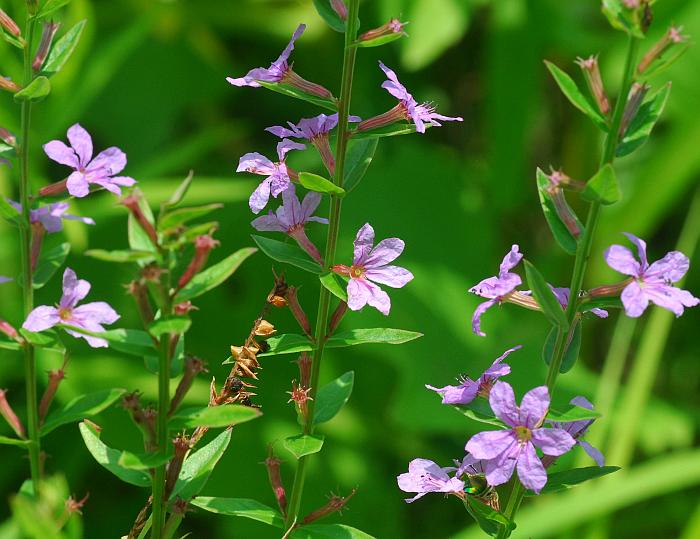Lythrum alatum Pursh
Winged Loosestrife

Native
CC = 6
CW = -5
MOC = 81
© SRTurner
Lythrum alatum PurshWinged Loosestrife | |
 |
Native CC = 6 CW = -5 MOC = 81 |
© SRTurner |
|
Family - Lythraceae Habit - Perennial forb with fibrous roots and rhizomes, often forming colonies. Plants glabrous. Stems - Ascending, to 80 cm, wandlike, angled and often narrowly winged, at least toward the tip, the wings interrupted and forming minute auricles at the nodes.
Leaves - Mostly opposite, but at least the uppermost leaves usually alternate, the lowermost leaves rarely in whorls of 3, simple, sessile. Blades 0.5-4.0 cm long, narrowly lanceolate to oblong-lanceolate or oblong-triangular, the upper leaves sometimes linear or narrowly elliptic, rounded to truncate or very shallowly cordate (rarely narrowed to tapered) at the base, bluntly to sharply pointed at the tip.
Inflorescence - Axillary flowers at the upper and often also median nodes, the flowers solitary or less commonly paired, in well-developed plants sometimes taking on the appearance of leafy terminal spikes, mostly short-stalked, each subtended by a pair of small bracts.
Flowers - Roughly actinomorphic, the hypanthium much longer than wide, cylindrical, symmetric at the base, the hypanthium plus sepals to 7 mm long, with 8-12 longitudinal ridges. Sepals 6, triangular to broadly triangular, more or less ascending, the appendages about twice as long as the sepals, thickened, narrowly conic-triangular, arched outward. Petals 6, 3-7 mm long, pinkish-purple or rose-pink, 5 mm long, 2.2 mm broad, borne at edge of floral tube, with purple midvein. Stamens 6, unequal, adnate about 1/2 way up floral tube, included. Filaments glabrous, 5 mm long, purplish. Anthers usually dark purple. Style glabrous, white, exserted. Stigma globose-capitate, greenish. Pistils with a nectary disc.
Fruits - Capsules 4-6 mm long, narrowly ovoid to oblong-ellipsoid, dehiscing longitudinally. Seeds numerous, 0.4-0.6 mm long.
Flowering - May - September. Habitat - Streambanks, marshes, fens, bottomland prairies, wet depressions of upland prairies and glades, ditches, edges of crop fields, railroads, roadsides, wet disturbed areas. Origin - Native to the U.S. Lookalikes - Sometimes, L. salicaria. Other info. - This species can be found throughout Missouri but is uncommon in the bootheel portion of the state. Its main range is within the U.S. Midwest. The plant is easily recognized by its wet habitat and distinctive flowers with cylindrical hypanthia and somewhat disheveled-looking petals which commonly have darker purple stripes down their middle. The entire plant is glabrous and usually has a number of alternate leaves toward the branch tips. These latter characteristics distinguish it from the notorious L. salicaria (purple loosestrife), which is exotic and invasive in some areas. L. alatum, in contrast, is a well-behaved native member of our flora. It can make a good garden subject for moist or wet areas. Photographs taken at the Shut-In Mountain Fen, Shannon County, MO., 6-25-04 (DETenaglia); also at Shaw Nature Reserve, Franklin County, MO, 6-22-2014, and Whetstone Conservation Area, Callaway County, MO, 7-15-2016 (SRTurner). |